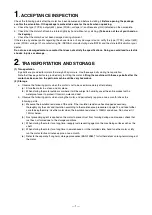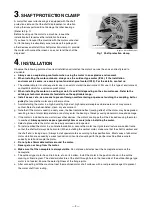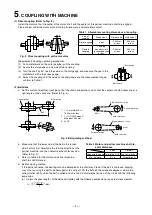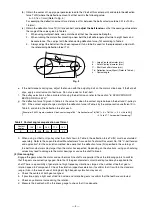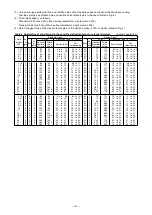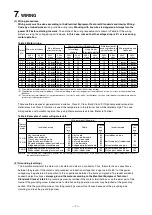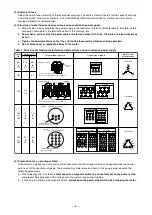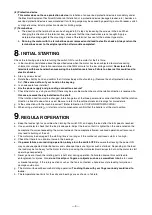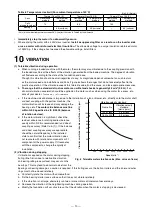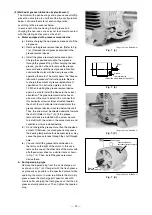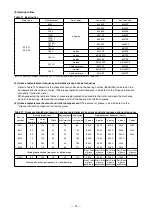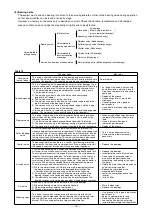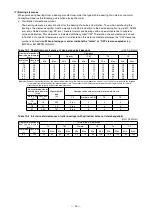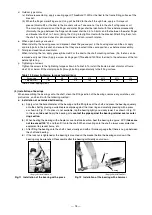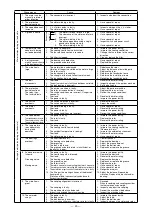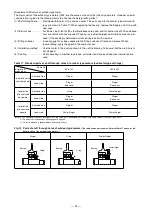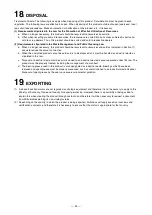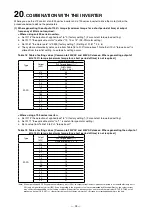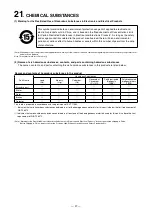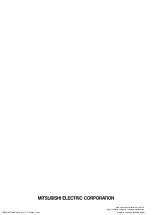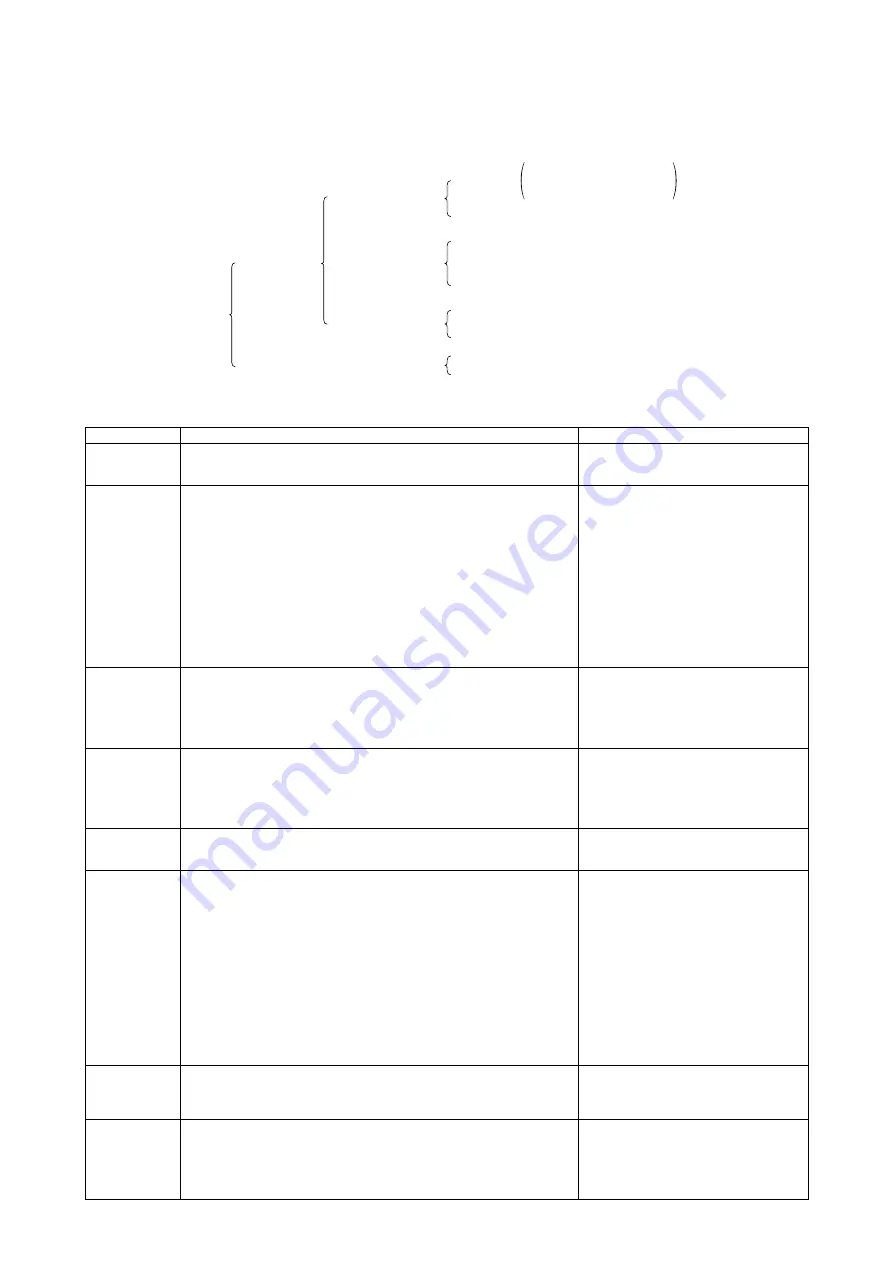
– 15 –
(6) Bearing noise
The easiest way to check a bearing is to listen to the noise it generates. Listen to the bearing noise during operation
so that abnormalities can be found at an early stage.
However, do not rely on the noise only to decide pass or fail. Check the vibration, temperature and discharged
grease so that you do not judge the practically all right parts to be defective.
Noise related to
rolling bearing
Bearing noise
Noise when bearings are assembled
Motor groaning noise (Ball bearings and roller bearings)
Intricate noise
Noise related to
bearing manufacture
Noise related to
incorrect handling
of bearings
Race noise
All bearings
Mainly, single row deep
groove radial ball bearings
Squeaking noise (Roller bearings)
Retainer noise (Ball bearings)
Roller dropping noise (Roller bearings)
Chatter noise (All bearings)
Scratch noise (All bearings)
Dirt noise (All bearings)
Table 13
Cause of noise
Measures
Race noise
(normal noise)
This noise is characteristic of the rolling bearing and occurs in every
bearing. The noise is generated when the roller rolls over the locus due to
rotation of the bearings. This should be a smooth and continuous noise.
Normal noise
Squeaking noise
This is a "squeaking" noise generated by almost all roller bearings. It is a
metallic sound, and is caused by the non-uniform movement of the rolling
element in a no-load area. This noise has the following characteristics.
1) This noise is heard when grease lubrication is used, and is rarely
heard when oil is used.
2) This noise occurs easily when the lubrication performance
(especially oil) is poor.
3) This noise occurs easily during the winter.
4) This noise occurs easily when only a radial load is applied and the
radial clearance of the bearings is large.
5) This noise occurs at a certain rotating speed range, and the range
differs according to the size of the bearings.
(If this noise is heard, try replenishing a small amount of the designated
grease. This noise may occasionally be heard in ball bearings.)
• As long as the noise is not caused
by a heavy load, and is only due to
vibration or temperature, use can be
continued.
• Replenish the grease.
• Use bearings with a small radial
clearance.
• Use soft grease with a good oil
performance.
• Use a bearing for squeaking noise
measures.
Retainer noise
This noise is heard when the retainer vibrates during bearing rotation
and collides with the rolling element. The noise is cyclic and has the
following characteristics.
1) This noise is heard in both grease lubrication and oil lubrication.
2) This noise occurs easily in ball bearings having a large radial clearance.
3) This noise occurs easily when a moment is applied to the outer bearing ring.
• When using ball bearings, decrease
the radial clearance or apply a pre-
load.
• Use a lubricant with a good
lubrication performance.
• Replenish the grease.
Roller dropping
noise
This noise is generated due to the radial clearance and the relation of the
clearance between the retainer and rolling element. If the bearing is being used
in a horizontal rotor, this noise is generated when the balls drop faster than the
retainer due to the gravity of the rolling element when in a no-load area near
the top, and collide with the retainer. This noise is not heard during low speed
operation or normal operation, and often occurs just before stopping.
• This is not an abnormal noise.
• Decrease the radial clearance if
necessary.
Chatter noise
The bearings vibrate when there is a circular spiral having a relatively
large crest on the inner/outer race raceway surface or rolling surface. If
the speed is constant, this sound will have a constant frequency.
• Replace the bearings.
Scratch noise
A cyclic noise sounding like a riveter and vibration occur if the raceway
surface or rolling surface has scratches (scratches, indentation and rust).
The cycle may be constant if the speed is constant. The cycle becomes
longer as the rotating speed drops. As for ball bearings, if the scratch is
on the raceway surface, the noise may be continuous. However, if the
scratch is on the ball, the noise may not be heard. The noise, however, is
still cyclic. This noise may sound differently after replenishing grease.
The major causes and characteristics are as follows.
1) While the motor stands still, vibration from other equipment causes
the bearing raceway surface to be damaged by scratches. The
scratches are at the same spacing as the ball-to-ball spacing.
2) An excessive radial load and/or excessive vibration causes the
bearing raceway surface to be damaged by fretting or peeling.
3) The electrolytic corrosion while driven by an inverter causes the
bearing raceway surface to be damaged by striped pattern scratches.
• Replace the bearings.
• Investigate the cause of scratches.
• Do not give an excessive impact
or shock to the bearings during
assembling the bearing or transport
the motor.
• Isolate the motor from the machine so
as not to vibrate the other.
• Reduce the radial load or the
magnitude of vibration.
• Lower the carrier frequency of the
inverter.
• Install a filter.
Dirt noise
A non-cyclic noise is heard when there is dirt in the bearings.
1) When the bearings were not completely washed.
2) When foreign matter entered the lubricant.
3) When dirt entered the bearings during rotation.
• Wash the bearings.
• Replace the bearings.
Groaning noise
This noise is caused by a resonance of the natural vibration of the
vibration system composed of the ball bearings axial spring and rotor,
and the vibration system formed between this assembly and the
bracket. This is caused by the resulting unstable vibration.
• Use grease with a good lubrication
performance.
• Apply an appropriate pre-load.
• Decrease the radial clearance.
• Loosen the fitting of the outer ring.
• Increase the axial rigidity of the bracket.

